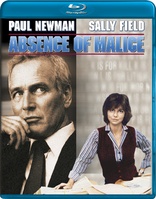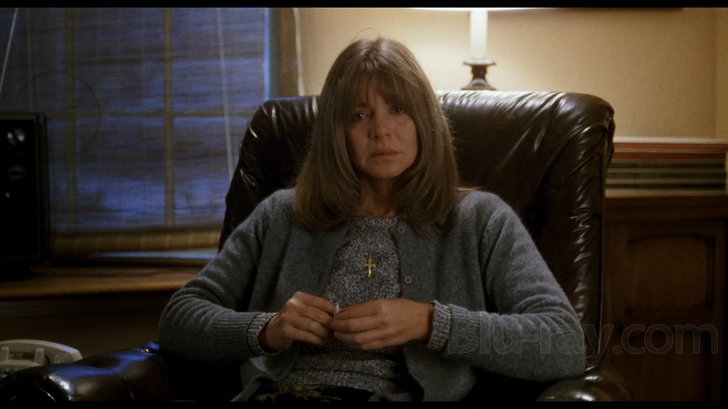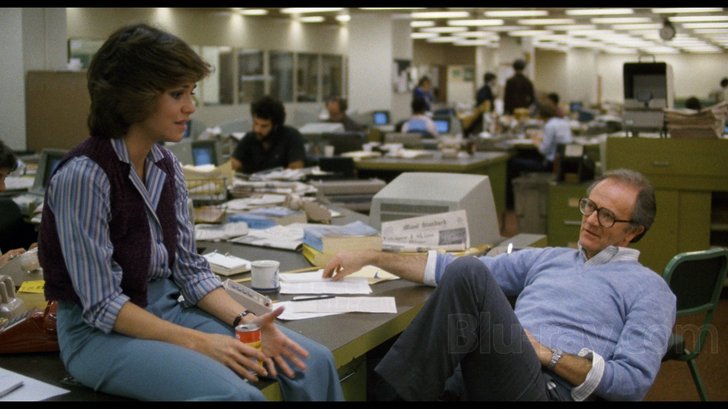Absence of Malice Blu-ray Movie
HomeAbsence of Malice Blu-ray Movie 
Image Entertainment | 1981 | 117 min | Rated PG | Nov 08, 2011
Movie rating
7 | / 10 |
Blu-ray rating
| Users | 4.0 | |
| Reviewer | 4.0 | |
| Overall | 4.0 |
Overview
Absence of Malice (1981)
A prosecutor leaks a false story to a reporter that the nephew of a mob boss is under investigation for murder, hoping to pressure the nephew into turning informant. The reporter has no responsibility for the truth of the story, only for accurately repeating what she's been told.
Starring: Paul Newman, Sally Field, Melinda Dillon, Wilford Brimley, Bob BalabanDirector: Sydney Pollack
| Romance | 100% |
| Thriller | Insignificant |
| Drama | Insignificant |
Specifications
Video
Video codec: MPEG-4 AVC
Video resolution: 1080p
Aspect ratio: 1.85:1
Original aspect ratio: 1.85:1
Audio
English: LPCM 2.0 (48kHz, 16-bit)
Case is incorrect
Subtitles
English SDH, Spanish
Discs
25GB Blu-ray Disc
Single disc (1 BD)
Playback
Region A (locked)
Review
Rating summary
| Movie | 4.0 | |
| Video | 4.0 | |
| Audio | 3.5 | |
| Extras | 3.5 | |
| Overall | 4.0 |
Absence of Malice Blu-ray Movie Review
Don't Blame Cable, Bloggers or Fox News; It Started Long Ago
Reviewed by Michael Reuben October 29, 2011Few mainstream directors in the last half of the 20th Century were as productive as the late Sydney Pollack, but two periods in his career stand out: the early Seventies, when he made The Way We Were and Three Days of the Condor; and the early Eighties, when he made Tootsie, the multiple Oscar-winning Out of Africa and Absence of Malice. The last merits renewed attention, not only because it contains a classic Paul Newman performance, but because it's an essential counterpoint to the much lauded (justifiably so) All the President's Men. What a difference five years can make. In that short time, the crusading journalists and courageous sources of Alan J. Pakula's film had become amoral careerists personified by Sally Field's reporter and Bob Balaban's cynical prosecutor. Instead of exposing government's abuse of power, the press became a tool of it, all for the sake of a story. "You don't write the truth", says Newman, playing an anguished private citizen who wakes up one day to find himself indicted in the court of public opinion by a front page story based on anonymous sources. "You write what people say." To our ears, that sounds like standard operating procedure, because it's what passes for journalism now: repeating what people say, no matter how ludicrous or unsupported. (As one wag noted, if an advocacy group issued a statement insisting the earth was flat, the headline would read: "Debate Rages Over Shape of Earth".) After leaked information helped bring down a president, everyone started doing it routinely, because everyone wanted to control the story. It's only a short step from there to manufacturing stories, which is what the prosecutor does in Absence of Malice. The title refers to a legal standard. "Malice", in the law of libel, means actual knowledge that a story is false. Normally, a newspaper or other media source commits libel by publishing a false statement damaging to a person's reputation where it was only negligent in failing to ascertain the truth. But under the Supreme Court's landmark decision in New York Times v. Sullivan, negligence no longer applies when the person in question is a so-called "public figure" (a concept that, as the newspaper's lawyer says in the film, is impossible to pin down). A public figure must prove that the newspaper knew the story was false and published it anyway. It's a standard that's almost impossible to satisfy, and that's the whole point, because the First Amendment is supposed to foster open and robust public discussion, even if it wrecks the lives of a few unfortunates who find themselves promoted to "public figures" by officials with a hidden agenda.

Pollack always like to establish a film's milieu as realistically as possible, and the title sequence of Absence of Malice is a lively mini-documentary on how newspapers were printed in the analogue era. Then we're plunged into the criminal investigation that drives the narrative. A prominent Miami labor official, Joey Diaz, is missing and presumed dead. The local mob, headed by Santos Malderone (Luther Adler), is the chief suspect, having fought for years to keep unions out of Miami. A federal strike force headed by a Justice Department weasel named Elliot Rosen (Bob Balaban) has been organized to crack the case. Rosen is supposed to coordinate with the local U.S. Attorney, James Quinn (Don Hood), but Rosen likes to do things his way. (Today we'd say he "goes rogue".) Trivia note: Quinn is consistently referred to as a "D.A.", which is a state prosecutor, not federal. Since screenwriter Kurt Luedtke, a former journalist, got all the other legal terminology right, this appears to be deliberate. Maybe Luedtke and Pollack didn't think the audience would understand that a "U.S. Attorney" is a prosecutor. Rudy Guiliani wasn't yet a household name. Stymied in his investigation, Rosen decides to squeeze the nephew of Santos Malderone, Michael Colin Gallagher (Newman), even though Gallagher is widely known to be a straight arrow, having taken over his late father's wholesale liquor business, but not his smuggling operation. An ambitious reporter for the Miami Herald, Megan Carter (Field), is always buzzing around the strike force, exchanging pleasantries with one of the FBI agents, Waddell (Barry Primus), whom she used to date. (Whether for business or pleasure is never entirely clear.) Rosen lets Megan into his office for an "interview" in which he says nothing, but he arranges to be called out of the office, leaving Megan there with Gallagher's file conspicuously sitting on his desk. She reads the file and submits a front-page story, vetted by her editor, "Mac" (Josef Sommer), reporting that Gallagher is a key suspect in the Diaz investigation. Mission accomplished, pressure applied. Gallagher's life begins to fall apart. His employees will no longer report for work, because their union believes he's connected to the murder of a labor hero. Truckers stop delivering. Long-time customers cancel accounts. Uncle Santos has men following him to see whether he'll make a deal. And when Gallagher goes to confront Megan and Mac, they won't tell him anything about their sources. (It's standard journalistic practice.) It gets worse. Gallagher has an air-tight alibi for the Diaz case, but it's one he can't disclose without gravely injuring someone else. He was out of town when Diaz disappeared, helping a childhood friend, Teresa Perron, deal with difficult personal issues. Teresa is a sweet but troubled woman who works at a Catholic school and still lives with her father. She's played by Melinda Dillon, who most will recognize as the mother determined to find her missing child in Close Encounters of the Third Kind. Not realizing that the accusations against her friend Michael aren't the real issue, Teresa seeks out Megan Carter in an attempt to clear her friend and finds intimate details of her life spilled all over the front page. The scene in which she waits by the front door to intercept the paper before her father can see it is heart-breaking. (Dillon was nominated for an Oscar for her performance.) Gallagher eventually learns that Rosen was behind the leak and goes about setting him up by his own devices: leaks, false trails, planted news stories. Eventually everyone finds themselves hauled into a room in the federal building to be grilled by an exasperated Assistant Attorney General named Wells, who's been dispatched from Washington to find out "what in Christ is going on around here". Wells is played by Wilford Brimley in what was then his most significant role to date, and director Pollack tells the story of how Brimley was cast with obvious relish in the accompanying documentary. If there's a bit of preachiness in Wells's pronouncements (and there almost has to be at this point in the story), Brimley has the down-home authenticity to bring it off. He's the ideal counterweight to Newman's Gallagher, who says very little in the extended scene -- it plays like an informal trial -- but speaks volumes with the way he reacts to everything that's said. "We'd had a leak", U.S. Attorney Quinn tries to explain to Wells, and Gallagher smiles with delight as Wells interrupts him:
You had a "leak"? You call what's goin' on around here a "leak"? Boy, the last time there was a leak like this, Noah built hisself a boat.Parts of Absence of Malice may seem contrived. In particular, the romance between Megan Carter and Gallagher has been called far-fetched (and certainly unprofessional on Megan's part). But is it really a romance? We know from the outset that Megan dates sources, and we see her string along Waddell, the FBI agent. There's barely an encounter between Megan and Gallagher where we don't see some clash of agendas, as one or the other (or both) looks for information or insight into the larger game being played. Sure, there's an attraction between them, but it's always accompanied by some element of "business". (Pollack notes in the documentary that he wanted Field for the part, because he needed her likeability to offset all the terrible things Megan does as a reporter, which is what she remains first and foremost.) And while it may be inappropriate for sources and reporters (or doctors and patients or lawyers and clients) to become romantically involved, anyone who thinks it doesn't happen is living in fantasyland. Absence of Malice was the last film in which Newman played anything resembling a traditional romantic lead, and he could still bring it off effortlessly at age 55 (and playing a good ten years younger). The following year, with The Verdict, Newman moved into an entirely new and rich phase of his career, playing older men with a clear sense of who they are and where they've been, using his incomparable gift for expressing a character's thoughts without words to convey a sense of the weight of years of accumulated experience. If for no other reason, Absence of Malice is worth seeing to savor Newman's last go-around at the kind of passionate younger role that made him famous. I challenge anyone to watch the scene where Gallagher explodes and attacks Megan and not feel disturbed by the violence.
Absence of Malice Blu-ray Movie, Video Quality 

Image's 1080p, AVC-encoded Blu-ray provides a nice presentation of the low-key, realistic cinematography by regular Pollack collaborator Owen Roizman, who can do everything from gritty urban street style (The French Connection) to glossy period photography (Wyatt Earp). This is the kind of image that is usually described as "soft" by viewers who experience most films on video and as "film-like" by those (like me) who grew up seeing movies projected on film. It's a detailed image with colors that are saturated (but not overly so), good black levels, natural-looking grain and no apparent attempts to modernize the photographic style or process the texture to create "pop". The source material is in excellent shape, although the closing title sequence, which depicts boats in the inland waterway will strike some as excessively grainy, probably because of the optical processing required to include the titles. I saw no signs of high-frequency filtering, transfer-induced ringing or other inappropriate digital tampering, nor did I spot any compression artifacts.
Absence of Malice Blu-ray Movie, Audio Quality 

The PCM 2.0 track (and not DTS-HD MA, as indicated on the case) preserves the film's original audio format. It's a front-oriented mix with limited surround presence, even when processed through DPL IIx decoding. Dialogue remains clear and centered, as do essential sound effects. There is almost no sense of stereo separation, except that Dave Grusin's score -- insistent and staccato-inflected for the newspaper scenes, gently emotional for the personal scenes -- spreads across the front soundstage. Grusin's score is one of his best, for my money. It greatly aids in modulating the film's tricky shifts in tone, as it moves between individual relationships and the larger events in which they've been swept up.
Absence of Malice Blu-ray Movie, Special Features and Extras 

Sony previously released Absence of Malice on DVD in 1998. Image released a DVD in December 2010, but according to their online catalogue, that release did not include any extras.
- Deleted Scene (SD; 1.85:1, non-enhanced; 1:02): A short scene between Gallagher and his banker, as Gallagher's wholesale liquor business struggles.
- The Story Behind Absence of Malice (SD; 1.78:1, non-enhanced; 31:04): Produced and directed by Charles Kiselyak, this featurette has a copyright date of 2001, but I have not been able to locate an R1 DVD edition on which it previously appeared. It's a wonderfully entertaining series of interviews with Pollack, Newman, Field and Luedtke about the film, its development, its themes and the experience of making it.
- Theatrical Trailer (HD; 1:85; 2:03): An effective and accurate promotion.
Absence of Malice Blu-ray Movie, Overall Score and Recommendation 

Absence of Malice is an "issue" movie, but it's an issue that not only hasn't gone away, but has also become knottier and more treacherous as technology has increased the speed of information's spread and, with it, the intensity of competition to be first to get the story. Pollack, Luedtke and an exceptional cast dramatized the issue effectively so that it lives and breathes beyond a series of talking points, which is exactly what narrative fiction is supposed to do. Only a born storyteller could appreciate the irony of showing Santos Malderone cackling over how his nephew, Gallagher, turned various law enforcement people against each other -- and get the audience laughing with him, even though it was probably Malderone who killed the labor organizer, Diaz, and started the whole mess. The film is highly recommended, and so is the Blu-ray.
Similar titles
Similar titles you might also like

The Big Easy
1986

Two for the Seesaw
1962

Up Close & Personal
1996

Moonlight Mile
2002

Final Analysis
1992

Spread
2009

The Paradine Case
1947

Snow Falling on Cedars
Collector's Edition
1999

Indecent Proposal 4K
1993

Irreconcilable Differences
1984

Cruel Intentions
1999

Intermezzo: A Love Story
1939

A Place in the Sun
Paramount Presents #22
1951

All the Real Girls
2003

Freeheld
2015

Remember the Night
1940

Madame Bovary
Warner Archive Collection
1949

Keep the Lights On
2012

Wuthering Heights
2009

Like Crazy
2011